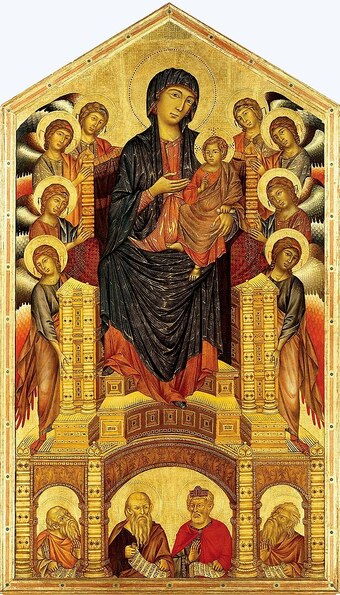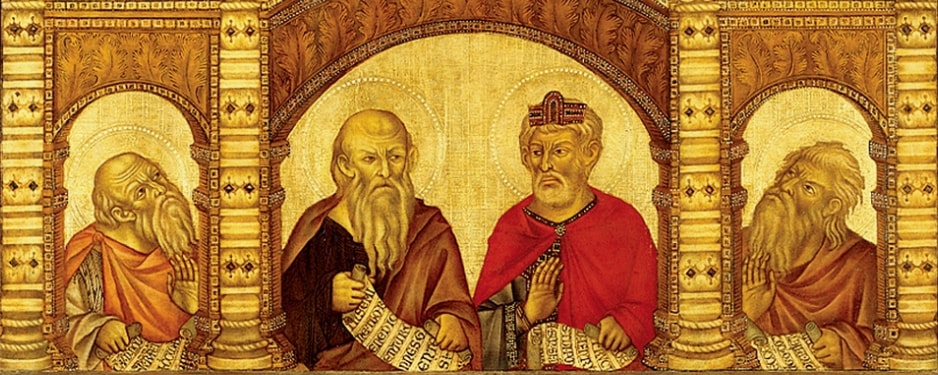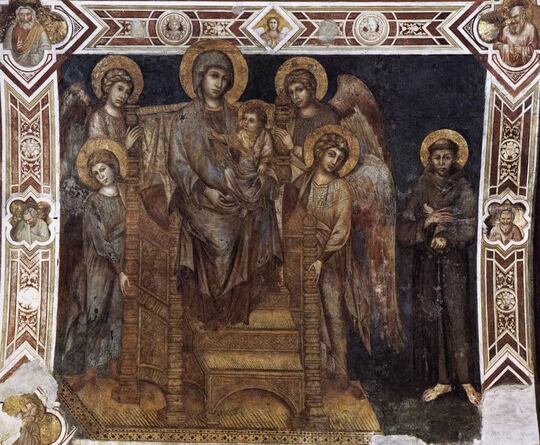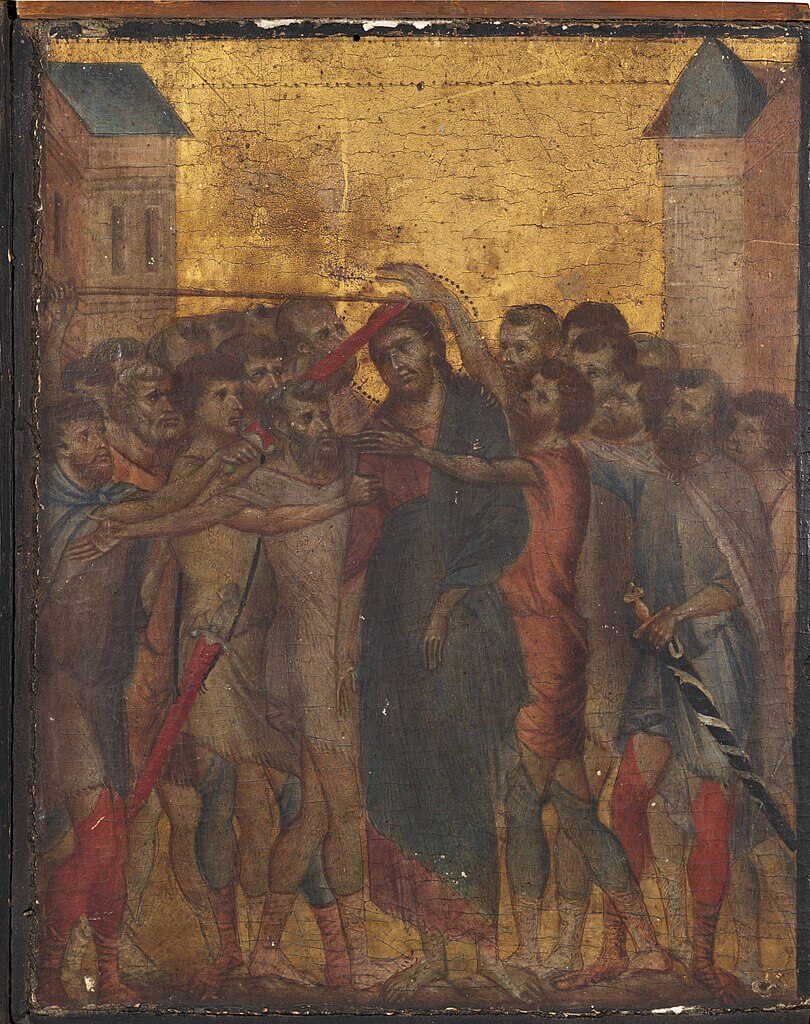|
Where? Gallery 2 of the Uffizi Museum
When? Some time between 1280 and 1300, the precise date continues to be debated. Commissioned by? Probably by the Vallombrosans, a monastic order of the Catholic Church. What do you see? A majestic, Gothic altarpiece, in Byzantine tradition with the remarkable first signs of humanism that would dominate the Renaissance style. It measures 12’8” by 7’4” (385 by 223 cm) and is painted on large vertical wooden panels with golden background. The Virgin Mary is seated on an impressive marble throne, decorated with carvings, gems and mosaic designs, much like those seen in Tuscan churches of the time. She points to Jesus with her right hand, entreating viewers to seek salvation through Christ. The Madonna holds Jesus in the traditional Byzantine manner according to the icon, Hodegetria, meaning, “She who shows the way”. Jesus is dressed as a philosopher from ancient times and gestures a blessing while holding a rolled scroll in his left hand which is believed to be the scroll of law. The gilding on the clothing and drapery of the material they wear has been done using the Byzantine technique of “agemina”, indicating the application of 2 filaments (2 metals), of the precious golden decoration known as damascene.
If it was commissioned by the Vallombrosan Order, they may well have requested the presence of the four prophets as they placed great emphasis on the Old Testament prophets in their literary and artistic traditions. Many other religious orders were being formed at the time and competition for the loyalty of Florence’s wealthy citizens and their financial support was important to any order. This spectacular and innovative Maestà that Cimabue created would certainly have brought new attention and prestige to the Vallombrosan at Santa Trinita. This large work would have been venerated with the intense devotion that the icons of the Byzantine style demanded, but it would also have been seen as a departure from the purely religious objective. What is a Meastà? Maestà is the Italian word for “majesty” and refers to the iconic formula of the enthroned Madonna as the Queen of Heaven with the Christ Child in her arms. She may or may not be surrounded by a court of angels and saints. It was a most common subject in the 13th and 14th centuries and was the object of intense devotion. Innovations: After some of the ancient Greek and Roman painters, Cimabue is one of the first to show linear perspective and to play with spatial features in his art. His figures take on volume and presence as they engage viewers not only in a pictorial story but also an important dialogue. His elegant angels have carefully designed hairstyles, each wearing decorative head bands. We can see two, wearing fashionable sandals, their bodies fill the volume of their diaphanous, draped clothing to the point that the knees are visible. They fully occupy the same space as the Madonna, helping to emphasize her importance but with more natural appearance. We can still see the elongated bodies and fingers, and the almond-shaped eyes of the Byzantine figures. The Madonna, by her size alone, continues to be the most important figure. Of note is the chiaroscuro effects of light and dark in the shading of the faces, suggestive of a light source, unseen in most Medieval work. Cimabue’s figures lose the rigidity of Greek and Byzantine art and for the first time since the Roman period, human emotions are seen in Florentine art. This can also be seen, for example, in his Crucifix (1268-1271) in the Basilica di Santa Croce in Florence. In this painting, Christ is showing the emotions on his face around the moment of his death.
Who was Cimabue? Cimabue was born c. 1240-45 in Florence and died in Pisa in 1302. He was a very innovative painter and used linear perspective, reintroduced volume and space, and, most significantly, human emotion in his paintings. While not much is known about his life, Cimabue first appeared in recorded history when it was noted that he witnessed the assumption of patronage by Pope Gregory X (Monastery of Saint Damiano) on June 18, 1272 in Rome. That he was in attendance suggests he was an experienced, well known and respected Florentine artist by that time, particularly as he had traveled from Tuscany to Rome for the event.
In art history, he has generally been overshadowed by his younger contemporaries, Giotto (1267-1337) and Duccio (c.1255/60-1319). He was known as a master of mosaics, frescoes and paintings. It has been said of him, “Without Cimabue, there would have been no Giotto.” He is remembered as the man whose style inspired the movement that formed the Florentine School but the School is attributed to Giotto, as he carried it forward into the Renaissance. Cimabue is also known as Cenni di Pepo or Cenni de Pepi which translates to “bull-head” or “one who crushes the views of others”. A contemporary of his said in 1333 or 1334, “a nobler man than anyone knew, but he was, as a result—so haughty and proud that if someone pointed out any mistake or defect in his work, or if he noted any himself, he would immediately destroy the work no matter how precious it might be.” This information suggests he was a perfectionist and perhaps arrogant along with it. An example of his fresco work is the Madonna with Child Enthroned, Four Angels and St Francis which he painted in 1278-1280 and can be found in the transept of the Lower Basilica of San Francesco in Assisi.
Fun Fact: Dante, in the Divine Comedy, Canto XI, lines 94-96, in writing about pride, wrote of Cimabue: “In painting, Cimabue thought he held the field, and now it’s Giotto they acclaim—the former only keeps to shadowed fame.” This was written between 1308 and 1321, just a few short years after Cimabue had died. However, some 8 centuries later, Cimabue may well find himself in the limelight once again.
In 2019, a small painting was found in France, in the farmhouse of a woman who had retired. It had hung on the wall for years, thought to be a Greek icon. A sharp-eyed auctioneer noticed it and saved it from the rubbish. It was quickly identified as, Christ Mocked by Cimabue. Christ Mocked sold for $26.6 million in October, 2019, making it the most expensive painting sold from before 1500. Evidence was not only based on the painting style but also by the worm tunnels that matched up with the panels of wood of two other works by Cimabue: The Virgin and Child with two Angels in the National Gallery in London and The Flagellation of Christ in the Frick Collection in New York. The three paintings below are part of the Diptych of Devotion, which consisted of two doors with four paintings each. This means that the remaining five paintings are still missing today.
2 Comments
|
Categories
All
|
- Home
- Blog
-
Museums
- Alte Pinakothek
- Art Institute of Chicago
- Baltimore Museum of Art
- Barber Institute of Fine Arts
- Bargello
- Barnes Foundation
- British Museum
- Church of Sant’Anastasia
- Cleveland Museum of Art
- Courtauld Institute of Art
- Detroit Institute of Arts
- Frans Hals Museum
- Galleria Borghese
- Gallerie dell'Accademia
- Getty Museum
- Guggenheim
- Hermitage Museum
- Kunsthistorisches Museum
- Kunstmuseum Basel
- Legion of Honor Museum
- Louvre
- Mauritshuis
- Metropolitan Museum of Art
- Musee d’Orsay
- Museum of Fine Arts in Boston
- Museum of Modern Art
- National Gallery in London
- National Gallery of Art
- National Museum in Poznań
- Norton Simon Museum
- Ny Carlsberg Glyptotek
- Palace of Versailles
- Palazzo Pitti
- Palazzo Vecchio
- Petit Palais
- Philadelphia Museum of Art
- Prado
- Pushkin Museum
- Ravenna Art Museum
- Rijksmuseum
- San Diego Museum of Art
- Santa Maria delle Grazie
- St. Peter's Basilica
- Städel Museum
- Statens Museum for Kunst
- Tate Britain
- Tate Modern
- Timken Museum of Art
- Uffizi
- Vatican Museums
- Wallace Collection
-
Artists
- Altdorfer
- Anguissola
- Berlin Painter
- Bosch
- Botticelli
- Boucher
- Bronzino
- Bruegel the Elder
- Brunelleschi
- Cabanel
- Caillebotte
- Canova
- Caravaggio
- Carpeaux
- Cezanne
- Cimabue
- David
- Degas
- Delacroix
- De Maria
- Donatello
- El Greco
- Fontana
- Fra Angelico
- Fragonard
- Gauguin
- Gentileschi
- Gericault
- Gonzalez-Torres
- Goya
- Hals
- Hogarth
- Hokusai
- Ingres
- Leonardo da Vinci
- Lippi, Filippo
- Longhi, Barbara
- Lorrain
- Makovsky
- Manet
- Massys
- Matisse
- Merian
- Michelangelo
- Mochi
- Modigliani
- Monet
- Panini
- Parmigianino
- Perugino
- Picasso
- Pisanello
- Raphael
- Rembrandt
- Renoir
- Reynolds
- Rivera
- Rodin
- Rubens
- Scultori
- Seurat
- Steen
- Tintoretto
- Titian
- Toulouse-Lautrec
- Turner
- Uccello
- Van der Weyden
- Van Dyck
- Van Eyck
- Van Gogh
- Van Hemessen
- Vasari
- Velazquez
- Vermeer
- Veronese
- Vigée Le Brun
-
Locations
- Books
- About Us








